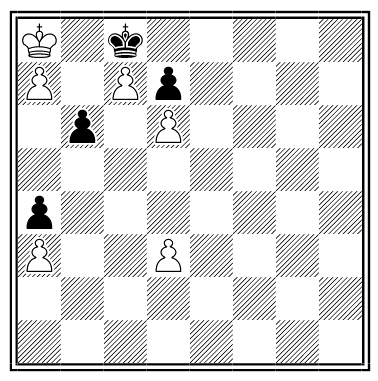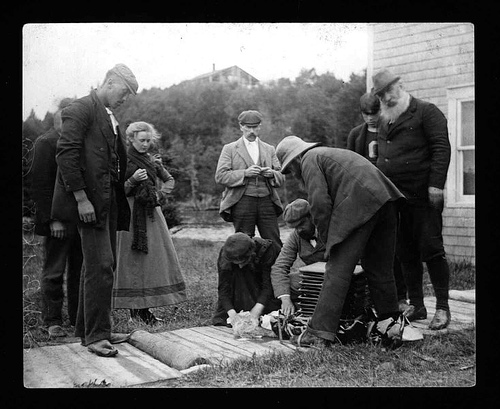DEIFIED is a palindrome.
Rimshot
A neutron walks into a bar and orders a beer.
“How much do I owe you?” he says.
“For you,” says the bartender, “no charge.”
A Self-Solving Chess Problem

White to move. I won’t give the solution — try it out and you’ll see why.
(Composed by V. Röpke, Skakbladet, 1942.)
Unquote
“I’m just glad it’ll be Clark Gable who’s falling on his face, and not Gary Cooper.” — Gary Cooper, declining the lead role in Gone with the Wind
A Scramble for the White House
If you rearrange the letters in “Joe Biden” you get “Jibed One.” What do anagrams tell us about the rest of the 2008 presidential field?
- Hillary Clinton = Rant, Chilly Lion
- John Edwards = Jaws, Herd Nod
- Rudy Giuliani = Gaudily I Ruin
- Dennis Kucinich = Induces Inch Kin
- John McCain = No Jam Cinch
- Barack Obama = Maraca Kabob
- Bill Richardson = Rabid, Shrill Con
- Mitt Romney = Mime, Not Try
- Fred Thompson = Hemp-Fond Sort
And “Al Gore” yields “Galore”.
A Mathematical Limerick

The integral z-squared dz
From one to the cube root of three
Times the cosine
Of three pi over nine
Equals log of the cube root of e.
“Bogs of Butter”
‘At Stramore, in the county of Monaghan, near the town of Glaslough,’ say the newspapers of 1813, ‘a short time ago a quantity of butter was found in a bog on the lands of Thomas Johnson, of Armagh, Esq. at the depth of twenty feet beneath the surface of the ground. In consequence of the antiseptic qualities of the bog, the butter was found in a state of the most perfect preservation; its colour a statuary white. The person who found this butter mixed it with other unctuous matter, and formed it into candles for family use. It was more condensed in substance than butter usually is, but perfectly sweet in taste, and free from any disagreeable odour.’
— The Cabinet of Curiosities, 1824
The Price of Progress

After inventing the telephone, Alexander Graham Bell turned his attention to an artificial respirator.
That required some sacrifices. Here his daughter tries to resuscitate a drowned lamb.
Scrap Paper
In 1946, the inflation rate in Hungary reached 4.19 quintillion percent, a modern record.
By August, all the Hungarian banknotes in circulation would have bought one-thousandth of one U.S. cent.
Kangaroo Words
Kangaroo words contain smaller versions of themselves. INDOLENT, for example, contains the letters I-D-L-E, in order. Can you find the hidden synonyms in each of these words?
- ABIDE
- ALLOCATE
- ASSEVERATE
- ASTOUND
- CALUMNIES
- CATACOMB
- DEPOSITORY
- DESTRUCTION
- ENCOURAGE
- HONORABLE
- ILLUMINATED
- INEFFECTIVE
- REVOLUTION
- SCOUNDREL
- TRANSGRESSION
- UMPTEENTH
- UNSIGHTLY
